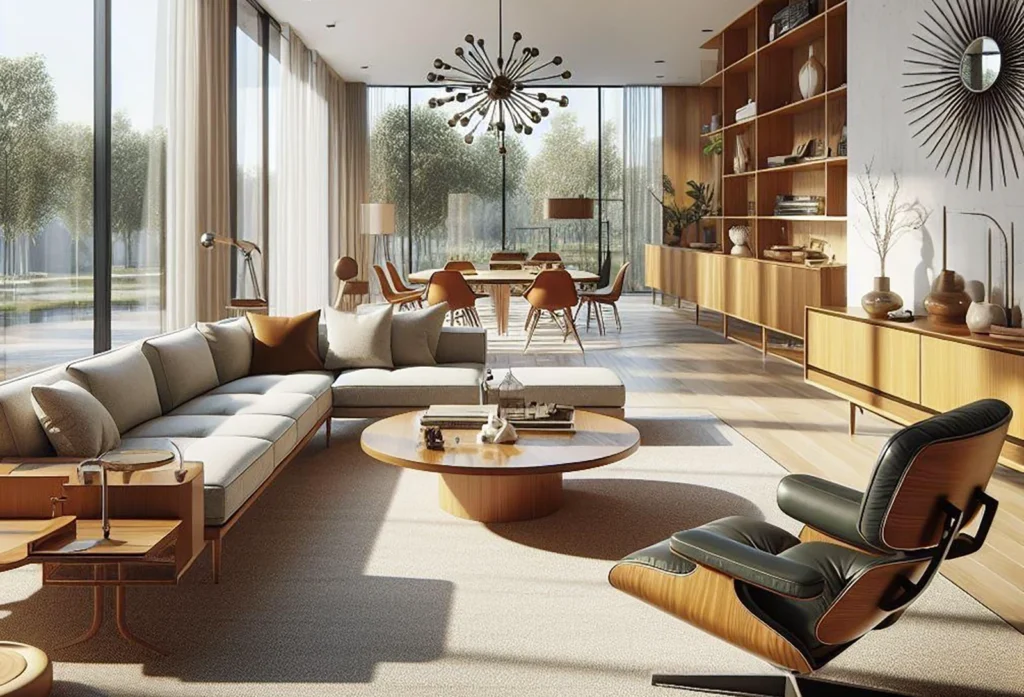
Midcentury Modern Life contains affiliate links and we may earn a commission when you click and make a purchase. This does not affect the price you pay and helps support the site. We only recommend products and services that we believe offer value to our readers.
The influence of midcentury modern architecture is unmistakable, with its clean lines, organic forms, and a seamless blend of indoor and outdoor spaces. As we progress into the digital age, one might wonder how this iconic style will evolve with the advent of Artificial Intelligence (AI). Will AI become a partner to architects, enhancing their creativity and efficiency, or will it replace them altogether? Let’s explore the potential of AI in designing homes, particularly those influenced by midcentury modern aesthetics.
AI as a Tool for Creativity and Efficiency
AI has already started making significant inroads into the world of architecture and design. Here are several ways AI can be a boon for creating modern homes:
Design Optimization:
AI algorithms can analyze vast amounts of data to suggest optimal designs. For instance, they can assess the best use of space, materials, and lighting to enhance both functionality and aesthetics. This capability is particularly valuable in midcentury modern designs, which emphasize open floor plans and the integration of natural elements.
Customization and Personalization:
AI can help create highly personalized designs tailored to individual preferences. By analyzing user preferences, lifestyle, and even behavioral patterns, AI can suggest designs that resonate with the unique needs of the homeowner, while still maintaining the core principles of midcentury modern architecture.
Sustainability:
One of the hallmarks of midcentury modern architecture is its emphasis on harmony with nature. AI can contribute to this by optimizing designs for energy efficiency, selecting sustainable materials, and incorporating renewable energy sources seamlessly into the home’s architecture.
Rapid Prototyping:
AI-powered tools can generate multiple design prototypes quickly, allowing architects to explore a wide range of options and make informed decisions. This can lead to innovative solutions that might not have been considered through traditional methods.
The Role of AI in the Architectural Process
Despite these advancements, the question remains: will AI replace architects?
The short answer is, not likely. Here’s why:
Human Creativity and Intuition:
Architecture is not just about functionality and efficiency; it’s an art form that requires creativity and intuition. While AI can provide data-driven insights and suggestions, the human touch is essential to create spaces that evoke emotion and tell a story. The subtle nuances of designing a midcentury modern home—capturing the essence of the era while infusing contemporary elements—require a level of creativity that AI alone cannot achieve.

Emotional and Cultural Sensitivity:
Designing a home is a deeply personal experience that involves understanding the client’s emotional and cultural context. Architects play a crucial role in translating these intangible aspects into tangible designs. AI can assist but cannot replace the empathetic connection between the architect and the client.
Collaboration and Problem-Solving:
Architecture often involves solving complex problems and navigating constraints related to site, budget, regulations, and more. Architects excel in collaborative problem-solving, negotiating between various stakeholders, and making judgment calls that balance aesthetic appeal with practical considerations.
A Synergistic Future
The future of architecture, particularly for midcentury modern homes, lies in a synergistic relationship between AI and human architects. AI can act as a powerful assistant, handling data-intensive tasks, optimizing designs, and providing valuable insights. This allows architects to focus more on the creative and human-centric aspects of their work.
For instance, an architect working on a midcentury modern project can use AI to analyze historical designs, understand their underlying principles, and generate contemporary interpretations that stay true to the original spirit. AI can also help in visualizing these designs through advanced 3D modeling and virtual reality, providing clients with a more immersive experience.
Moreover, AI can facilitate more sustainable and resilient designs, aligning with the midcentury modern ethos of harmony with nature. By leveraging AI’s capabilities, architects can push the boundaries of what’s possible, creating homes that are not only beautiful and functional but also forward-thinking and environmentally conscious.
AI is set to revolutionize the field of architecture, bringing numerous benefits to the design process. However, it will not replace architects. Instead, it will empower them, enhancing their ability to create stunning, personalized, and sustainable homes. For those passionate about midcentury modern architecture, this means a future where the timeless elegance of the past meets the innovative potential of the future, leading to designs that are as groundbreaking as they are beautiful.


